One of our favorite places on the entire planet is Kruger National Park. Every time we go, we feel like we’ve been transported to a wildlife paradise. Kruger is a top safari destination noted for easy access, budget friendliness, and some of the greatest diversity of wildlife available in Africa.
In our experience, one of the cheapest and best safari destinations in Africa is Kruger National Park. This is one of the few places in Africa where a couple can go on safari for less than $500 USD/day. It is affordable because you can rent a car and explore on your own and stay in comfortable yet reasonable accommodation inside the park.
Kruger NP is one of the few places in the entire world where you can witness grand wildlife spectacles on a less than spectacular budget.
How Much Does It Cost to go on Safari in Kruger?
A couple visiting Kruger on a modest budget can expect to pay about $200-$300 USD per day. Of course, prices will vary depending on the level of comfort and the amenities that you are willing to pay for.
This cost would be for a self-drive safari, including the price of a self-contained bungalow in one of the rest camps, a rental vehicle and groceries for self-catering.
Here’s a 2020 quote from the Sanparks online booking site for Skukuza, the largest rest camp. For a 5-night stay, a self-contained bungalow for two would cost 11,652 Rand – roughly $650 USD or $130 per day. A rental car and groceries would take care of the remaining $70. The conservation fee for international visitors is included in this price (about $25 pp/day or $50 per couple).
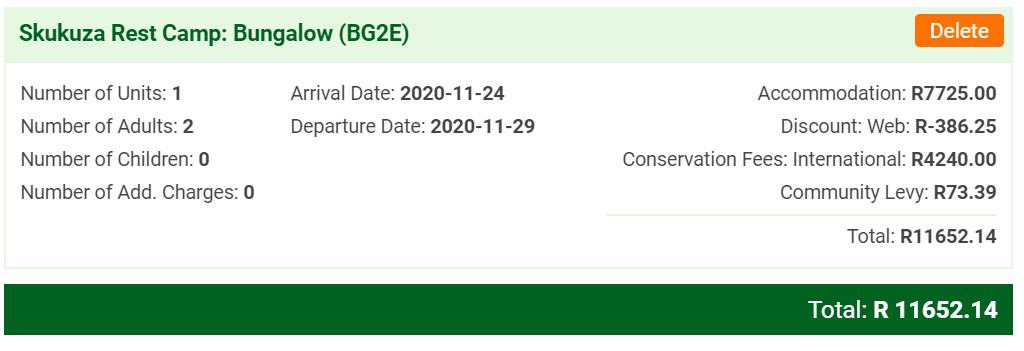
Five nights in a bungalow on the riverside will cost about 15,562 Rand or $900 USD – about $180 per night. If you splurge on a rental SUV and regularly eat at the cafeteria you could be looking at $300 USD per day for a couple.
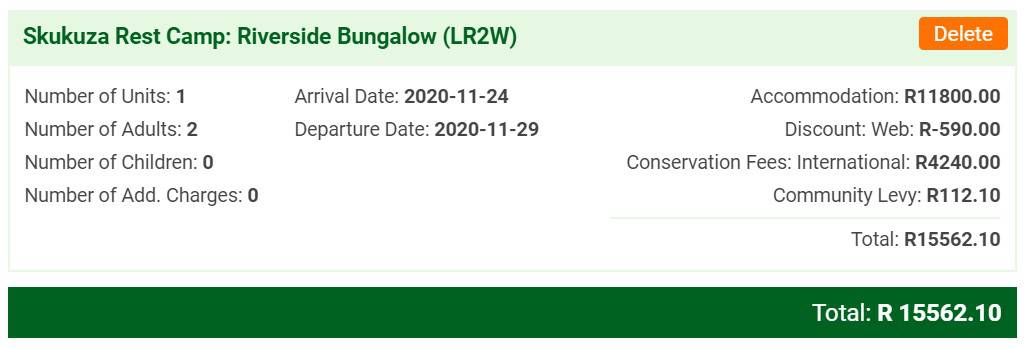
A self-drive safari in Kruger can literally save you hundreds or even thousands of dollars every day, compared to the price of a safari at one of the luxury private game reserves.
A luxury safari at a private game reserve adjoining Kruger will cost something like 12,000 to 20,000 Rand or more per person. For a couple that’s about $1,000-2,000 USD per day.
Private game reserves are worth the money if you can afford the rates; you receive a premium experience when you are on safari with a knowledgeable guide.
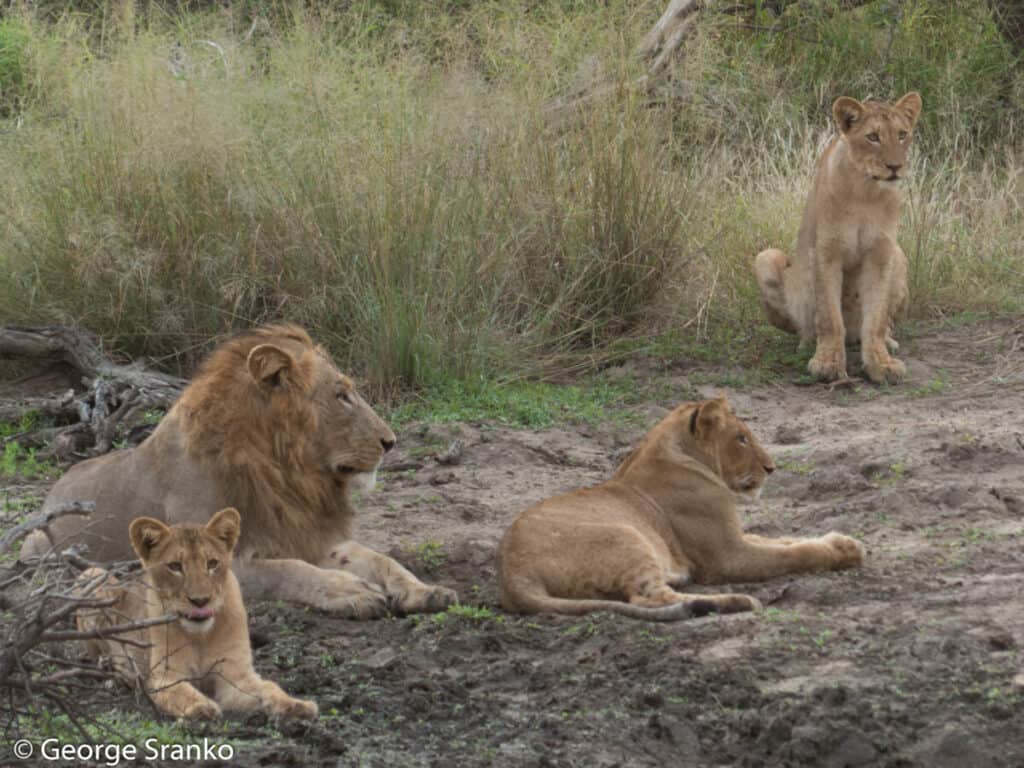
To this day, my best photographs of lions were taken in Balule, one of the private reserves adjoining Kruger NP without any fencing to impede the movement of wildlife. The guides would drive us to the lions until we were within a few meters of the pride. It is always exciting to sit in an open safari truck mere meters from lions who seemed totally inure to our presence. In their world, a safari vehicle is part of the backdrop; a regular occurrence that doesn’t represent any threat, so they go on with their daily activities.
What makes Kruger such a Good Value?
The beauty of Kruger is that you can enter the park for a reasonable fee and then spend your time freely driving on your own, discovering all the amazing wildlife and scenery at your own pace.
At the end of the day you can stay in one of several rest camps in the park, featuring a wide range of accommodation, from traditional camping sites and permanent safari tents, to self-contained huts and bungalows.
We enjoy staying in the bungalows – they are comfortable, with en-suite bathrooms and kitchenettes. And they are reasonably priced. You can read negative reviews, but our experience has always been positive. You can spend much, much more, of course, by staying at private lodges inside or outside the park, but what I like about the government run rest camps is that they allow you to stay in the park, close to the wildlife at an affordable price.
What is the Accommodation Like in Kruger?
As I’ve mentioned, there’s a wide range of accommodation available from campsites, safari tents to bungalows.
We prefer the self-contained bungalows with kitchenettes that include microwave, fridge, and electric kettle. The accommodation can be basic, but it is clean, the beds are comfortable and you will have a hot shower. The value for location can’t be beat in my estimation.
The larger camps have restaurants and, in most cases, supermarkets. Fuel is sold at the larger camps, and some even have ATM facilities and internet access. There are also five smaller bush camps for the fully self-contained adventurer who doesn’t require restaurants or shop facilities.
We’ve stayed at several rest camps and each has its own unique characteristics in terms of the habitat, terrain and the wildlife found in the area. Skukuza is the largest and the administrative center for the park, which may not appeal to some people. We have found it very handy because there are so many amenities, including a good restaurant and a supermarket shop that carries a wide range of items, including groceries.
One of the nicest things about Skukuza is that it is right on the Sabie river. The aspect that we appreciated the most was having a pathway alongside the river so that we could go for a walk. When you spend a few days in Kruger you soon realize that you are spending most of your time sitting in your car or in your bungalow, so it makes a big difference to have a rest camp large enough to go for a nice long walk along the river.
We like to stay at rest camps with river frontage, such as Lower Sabie, Skukuza, and Crocodile bridge. You’ll have a good chance of seeing wildlife without even leaving the camp. This can be handy in the late afternoon and evening when the gates are closed.
Two more really nice rest camps with great views include Letaba Rest Camp and Olifants Rest Camp. Both of these are in good game viewing areas. Olifants is perched on the edge of a steep bank overlooking the Olifants river. We’ve enjoyed sitting on our balcony with a drink in hand, watching hippos and elephants in the water and on the river flats far below.
Can I book my Accommodation Online?
Yes, you can register on the official South African National Parks website https://www.sanparks.org/bookings/.
Once registered you can work your way through the choices to the rest camp you prefer, your specific dates, the type of accommodation from campsite to bungalow, and the specific unit as in the example above: Skukuza Rest Camp: Bungalow (BG2E).
I would recommend booking as early as possible, since the best sites are in high demand.
You can book up to 11 months in advance. If you do a search online, you will find lots of people recommending their favorite sites in the various camps. I would recommend trying to find something near the perimeter. It will likely be quieter and closer to the wildlife on the other side of the fence.
Why Visit Kruger National Park?
If you have the slightest interest in wildlife, nature, and the amazing creatures on this planet, you will do yourself a big favor by putting Kruger on your bucket list.
On our very first visit to Kruger, we had only driven a few hundred meters from the entrance gate when we came upon a small family of elephants drinking and frolicking in a small river. We looked at each other, amazed that only minutes after entering the park we were already watching wild elephants in their native habitat. We parked our car on the side of the road less than 50 meters away, turned off the engine, and watched spellbound. They were sucking water into their trunks and spraying it into their mouths, over their backs, under their bellies… everywhere!
We couldn’t believe it — here we were in authentic Africa, witnessing an amazing wildlife spectacle that we will remember for the rest of our lives.
How Big is Kruger National Park? What are the Roads Like?
Kruger National Park is the size of a small country, at nearly twenty thousand square kilometers it is slightly smaller than Belgium.
It protects a huge range of natural habitats and biodiversity, is home to thousands of creatures, with over seven hundred species of birds, mammals, and reptiles – including the “big 5” – lion, leopard, rhino, elephant, and buffalo. There are some 12,000 elephants, 27,000 African buffalo, 18,000 zebra, and 1,500 lions in the park.
Kruger has a network of 1800 kilometers of well-maintained roads, with 21 rest camps, 2 private lodge concessions, and 15 private safari lodges. In our experience, the infrastructure is well designed to support a great wildlife experience without overly impacting the wildness of the park.
More than 300 archaeological sites have been found, with important archaeological discoveries at Thulamela and Masorini. You can discover cultural artefacts that are 100,000 years old and numerous examples of San Rock Art.

What is my favorite safari camera?
Panasonic LUMIX FZ300 Long Zoom Digital Camera – I love this camera for its versatility. It goes from wide angle to 28X optical in a relatively compact design
Ever wonder Why Lions Roar? check out my article on Lion Communication
Do you Need to Have a Guide?
People often wonder how a self-drive safari compares to an organized game drive with a guide or park ranger.
One of the great things about Kruger is that you can easily experience both. We recommend taking at least one early morning game drive with the national park staff and learning some interesting details and stories about the various wildlife you will encounter. The guides are a wealth of knowledge and offer fascinating insights on the terrain, vegetation, and wildlife. Every drive is different; you never know what you will see.
On one occasion we were in a large, open safari vehicle with about 20 seats when we came upon an aggressive bull elephant in musth (high testosterone makes them especially dangerous). Our guide drove slowly past the huge animal waving its trunk and flaring its ears. She told us to stay in our seats and not to get too excited, since we were safe. She assured us that the elephant wouldn’t charge since our truck was bigger than the animal was. Another story for friends and family!!
You will see amazing numbers of wildlife from your own vehicle! We’ve seen all of the big 5 in Kruger, Lion, Leopard, Rhino, Elephant and Buffalo – along with herds of antelope, giraffes, and elephants.
The great thing about a self-drive safari… you can park and watch and absorb the sights and sounds at your own leisure for as long as you like.
Drive slowly while scanning the bushes, the trees, and the road ahead and you will be amazed at the numbers of animals all around. One of the most pleasant experiences is to sit quietly with your windows open, listening to the sounds of the African bush and the abundant birdlife.
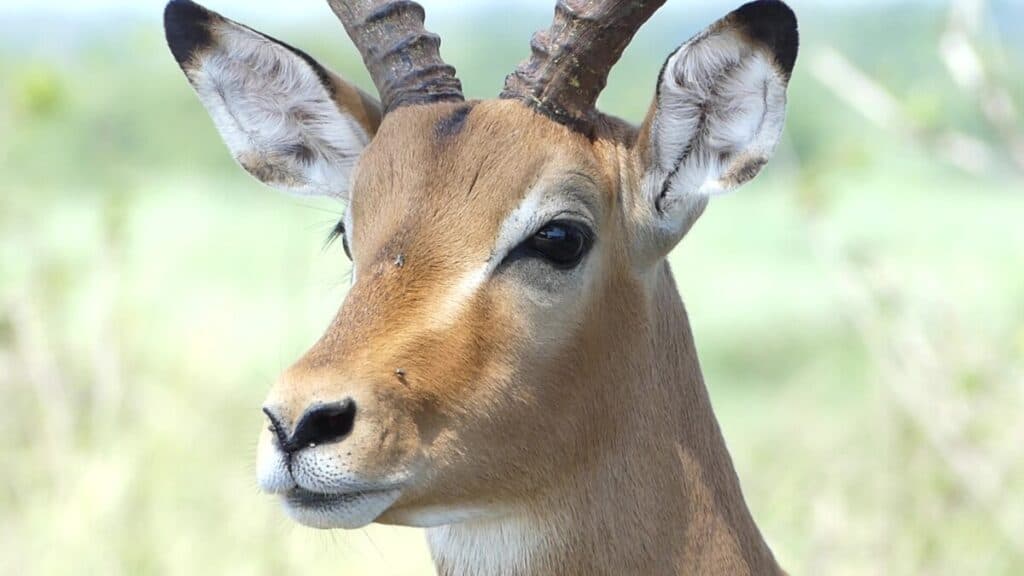
Of course, you need to be self-contained because you aren’t allowed to step outside of your car, unless at one of the fenced picnic sites or game hides. This just adds to the wildness of the experience when you drive along wondering whether a lion, leopard, or unpredictable buffalo might be lying unseen – keeping an eye on you!
Look for other vehicles; they’ll help spot something of interest. One or two cars usually indicates one of the more common sightings, such as buffalo, zebra, impala, baboons, or giraffes.
Big crowds usually mean big cats.
Some of our fondest memories feature lions that decide to lie down in the middle of the main park highway for a snooze. Traffic comes to a halt on both sides, with drivers jockeying for the best photo opportunities. Pretty soon you have a traffic jam with unperturbed lions at the center. In some cases, wildlife viewing can take a lot of patience! Isn’t this what its all about?
We Highly Recommend the Kruger NP Field App for Smartphones
We would highly recommend downloading the free Kruger National Park Field App to enhance your wildlife viewing. It provides excellent information about the various birds and animals that you will spot. If you pay a few dollars, it will show you updated ranges for the known lion prides in the park.
We really enjoyed using the app and found it helpful for identifying new animals. There are so many antelope, for example, that at first you may be wondering if you are watching Waterbuck, Impala, Bushbuck, Nyala or Kudu.
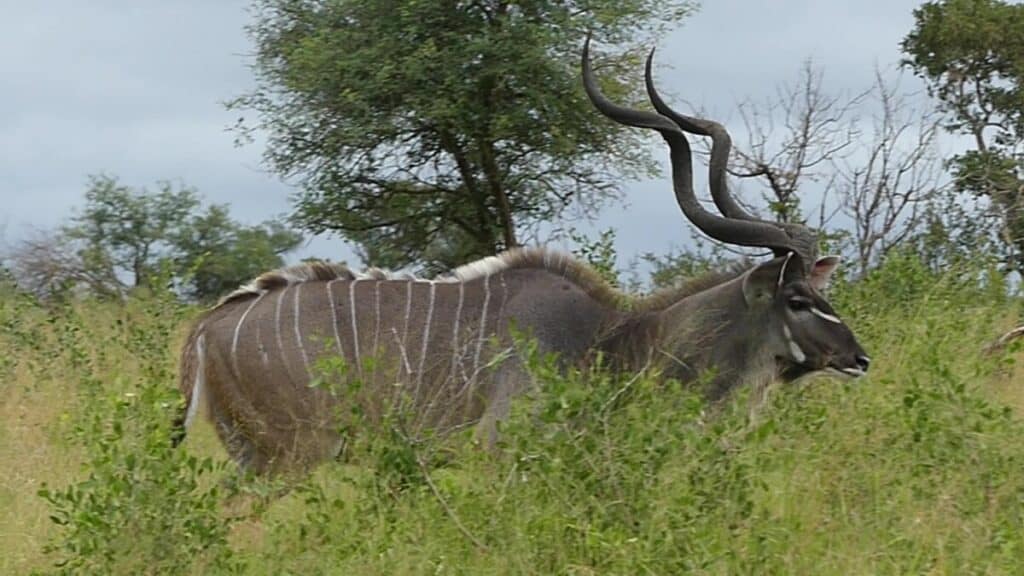
How do you get to Kruger?
You can drive from Johannesburg International Airport to Kruger National Park along the N4 in about 3 to 4 hours without stopping. You can also fly to airports on the outskirts and there’s even a small airport inside the park at Skukuza. We’ve taken scheduled flights to both Hoedspruit and Nelspruit. Hoedspruit Eastgate is a tiny airport suitable for accessing central Kruger, although the vehicle rental options are limited.
Probably the best option, especially for your first visit, would be to fly to Kruger Mpumalanga International Airport (KMIA/MQP) near the south end of Kruger.
There’s a good selection of vehicles available, just make certain the pick-up location is KMIA/MQP, not the old Nelspruit airport (NLP). MQP is midway between Nelspruit and White River, off the R40.
On our self-drive safaris, we’ve rented both ordinary passenger vehicles as well as SUVs. Either option will be fine for Kruger. There is a slight advantage to the SUV as you will be sitting up higher which is handy for looking over the tall grass. An SUV is more costly though, and, to tell you the truth, our experience from the passenger car was just as amazing. If you can afford the SUV, go for it, otherwise the passenger vehicle is fine. You don’t need a 4-wheel drive in Kruger, since all the roadways are well-maintained and you can even stay on asphalt if you prefer to avoid the gravel roads.
After picking up your rental vehicle, we recommend stocking up on supplies on your way to the park gate. There are large supermarkets in the bigger towns. The camp stores have limited supplies of groceries, although they great for back up. Don’t forget an inexpensive cooler box for your groceries and to keep drinks cold on your daily game drives.
When is the Best Time to Visit Kruger National Park?
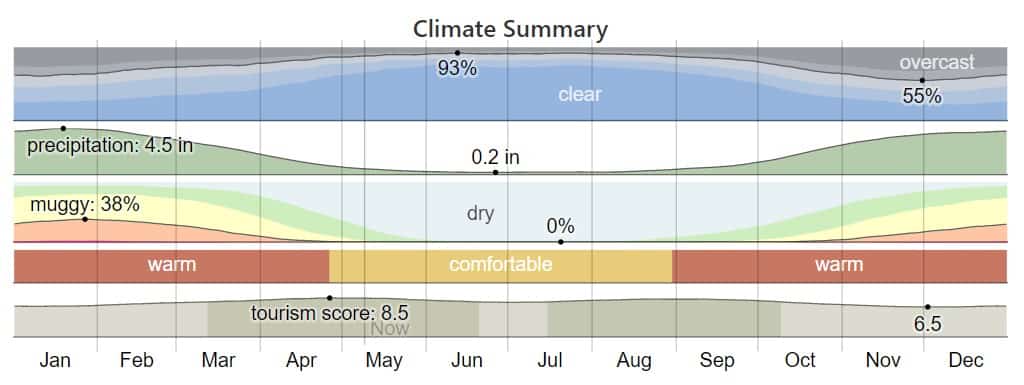
Sometimes we forget that seasons in the southern hemisphere are reversed from those in the northern hemisphere. The hot season in KNP is from October to March, and this is also the rainfall period. The park can be hot and humid at this time, with daytime temperatures ranging from the mid-20s C up into the 40s C (80′ F to over 100′ F). From April to September, nights can drop below 10’C (50′ F) but daytime temperatures are mostly perfect, sunny and in the low to mid-20s C (75-80′ F).
KNP is suitable to visit all year round, it just depends if you would prefer to avoid the peak precipitation from November to February. If you can, try to visit the park during the dry winter months of May to September, when temperatures are more moderate, there are fewer mosquitoes so the risk of contracting malaria is very low, and the thinner vegetation improves the odds of spotting wildlife. Some consider the end of the dry season to be the best time to visit, from August to October, when the animals can be found close to waterholes and rivers.
A personal story about our elephant encounter
As soon as we entered Kruger, we encountered a small family group consisting of five elephants; the large female, two smaller females, an adolescent male, and a small baby still learning to use its trunk. The baby was adorable, spraying water everywhere and stumbling around under the bigger elephants. It’s always amazing to see how the huge creatures keep watch on the babies and manage to avoid stepping on them.
After about 15 minutes, the large female matriarch came towards our car and stood staring at us. With her ears flared out, she reached up with her trunk to take a good sniff. She did not seem pleased that we were parked so close to her path across the road. I was afraid to turn on the engine in case the noise would upset her. She gave us a look that could not be mistaken: “don’t mess with my family!” After a minute or so she slowly ambled across the road just in front of our car. The rest of the family followed behind her. We breathed a sigh of relief. Thank goodness!
And then the young adolescent bull appeared in front of our car shaking his head and flaring his ears. He even trumpeted at us to make sure he had our undivided attention. Adolescent bulls can be testy and I don’t blame them one bit! When they reach early puberty at age 13 or 14, the mother and sisters become less welcoming and the young bull spends more and more time on the periphery. Soon he starts hanging around other family groups and similar aged males.
Biologists once thought that the adolescent bulls were forced out to be on their own, but recent research is showing that they hang around family groups until much older.
“Up until the age of about 25 they [males] are spending 80% of their time with family groups.”
Biologist Patrick Chiyo of the University of Notre Dame.
Once the young bull moved on to follow his family we sat in silence for a couple of minutes, reveling in the wonder of the interaction we had just experienced. And the fact that we had come through unscathed! That teenage bull gave us something we can never replace; a great story and a gentle reminder of the unpredictability and power of the natural world.
Up Close and Personal with African Wildlife – My Complete Presentation
In my African Wildlife presentation below I show some videos of our experiences in Kruger NP. Skip ahead to 35 min 50 sec. Of course, if you are interested in African wildlife, I’ve included lots of photos, videos, and stories that you might also find interesting. (If you like my YouTube channel please subscribe!)
The Gear We Take on Our Expeditions
We love to travel in search of exceptional wildlife viewing opportunities and for life-enhancing cultural experiences.
Here is the gear we love to travel with for recording our adventures in safety and comfort:
- Action Camera: GoPro Hero10 Black – we find these waterproof cameras are invaluable for capturing the essence of our adventures in video format. Still photos are great, but video sequences with all the sights and sounds add an extra dimension. I use short video clips to spice up many of my audiovisual presentations.
- Long Zoom Camera: Panasonic LUMIX FZ300 Long Zoom Digital Camera – I love this camera for its versatility. It goes from wide angle to 28X optical in a relatively compact design. On safari in Africa I’ve managed to get good shots of lions that the folks with long lenses kept missing – because the lions were too close! I also like the 120 fps slow-motion for action shots of birds flying and animals on the move. I call this my “bird camera.”
- 360 Camera: Insta360 ONE X3 360 – 5.7K 360 Degree Camera, Stabilization, Waterproof – see my article How to Take Impossible Shots with Your 360 Camera. This camera is literally like taking your own camera crew with you when you travel! Read my article and you’ll see why.
- Backpack camera mount: Peak Design Capture Clip
- Drone: DJI Mini 2 (Fly More Combo) – this mini drone is made for travel!
- Water Filtration: LifeStraw Go Water Filter Bottle
- Binoculars: Vortex Binoculars or Vortex Optics Diamondback HD Binoculars (good price)

